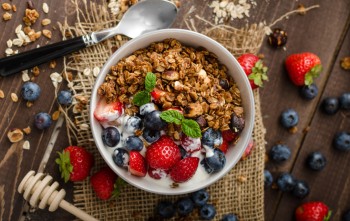Wheat Cereal: Healthy Breakfast with Many Benefits

Wheat as a nutritious food ingredient offers a multitude of health benefits. With its rich natural content of fiber, vitamins, and minerals, wheat cereal provides long-lasting energy and aids in maintaining a healthy weight.
Enjoy its diverse benefits, such as regulating blood sugar, supporting digestion, and reducing the risk of heart disease. There is no doubt that wheat cereal is a vital ally for a healthy and prosperous lifestyle.
Let's explore the world of wheat cereal together and summarize all the valuable information in the conclusion later. Happy reading!
What is Wheat Cereal?
Wheat is a type of cereal grain plant that serves as a vital staple food source worldwide. Wheat plants have tall, hairy stems and produce clusters of flowers that form spikes. The wheat kernels produced by these plants are used as a food ingredient and are processed into various food products, one of which is wheat cereal.
Wheat cereal is a food product made from processed wheat kernels to create cereal or snack items. The process of making wheat cereal involves heating, toasting, or rolling wheat kernels to achieve a crunchy and delicious texture suitable for consumption. Wheat cereal is often packaged in ready-to-eat containers and can be consumed by pouring milk or water over it, mixing it with yogurt, or eating it directly as a snack.
Wheat cereal is a popular breakfast choice because it is rich in nutrients such as fiber, vitamins, minerals, and complex carbohydrates. Consuming wheat cereal can provide long-lasting energy, help maintain a healthy weight, and support digestive health. Additionally, wheat cereal is often enriched with additional vitamins and minerals, making it a healthy and nutritious food option to start the day off right.
Benefits and Nutritional Content of Wheat Cereal
Here are some benefits of wheat cereal:
- Source of Fiber: Wheat cereal is rich in both soluble and insoluble fiber, which helps improve digestion, reduce the risk of constipation, and maintain intestinal health.
- Long-lasting Energy: The complex carbohydrates in wheat cereal provide long-lasting energy, stabilize blood sugar levels, and support daily activities.
- Weight Management: Consuming wheat cereal for breakfast is associated with reduced appetite, helping with weight control, and preventing excessive snacking.
- Heart Health: Wheat cereal contains fiber, vitamins, and minerals that can reduce the risk of cardiovascular diseases such as heart disease and stroke.
- Type 2 Diabetes: The fiber in wheat cereal helps regulate blood sugar absorption, potentially preventing and managing type 2 diabetes.
Nutritional Content of Wheat Cereal (per serving, usually around 30 grams):
- Calories: Approximately 100-150 calories.
- Protein: About 2-5 grams, essential for tissue formation and repair.
- Carbohydrates: Around 20-30 grams, providing a source of energy for the body.
- Fiber: About 2-5 grams, beneficial for digestive health and prolonged satiety.
- Fat: About 1-3 grams (usually low in saturated fat).
- B Vitamins: Such as thiamine, riboflavin, niacin, and folate, which are important for metabolic functions in the body.
- Minerals: Such as iron, magnesium, phosphorus, and zinc, which play various roles in bodily functions.
Differences Between Wheat, Oats, and Granola
Wheat
Wheat is a whole grain derived from the wheat plant. It is typically processed into wheat flour to make various types of bread, pastries, and other foods. Wheat is also used to make nutritious wheat cereal or oatmeal. Generally, wheat is used as a staple food rich in carbohydrates, fiber, and other nutrients.
Oats
Oats are a type of grain known for their high content of soluble fiber. Oats are processed to make oatmeal or oat porridge, which is a popular breakfast food. Oatmeal is typically served with water, milk, or yogurt and can be customized with various additions such as fruits and nuts. Oatmeal is rich in fiber, protein, vitamin B, and minerals like iron and magnesium.
Granola
Granola is a mixture of roasted grains such as wheat, oats, sunflower seeds, flax seeds, nuts, and often sweetened with honey or sugar. Granola is often used as a healthy snack or added to yogurt, milk, or smoothies for breakfast or a snack. While granola contains many nutrients such as fiber, protein, and healthy fats from grains and nuts, some commercial granola products may contain high added sugar and fats, so they should be chosen wisely.
Types of Wheat Cereals
- Regular Wheat Cereal: Commonly found wheat cereal, typically in the form of small dry grains. It can be served with milk or yogurt as a healthy breakfast.
- Sweetened Wheat Cereal: Wheat cereal with added sweeteners, such as sugar or syrup, for a sweeter taste. It's important to note that sweet varieties often contain more sugar and should be consumed in moderation.
- Granola: A mixture of roasted grains, such as wheat, oats, sunflower seeds, and nuts, often sweetened with honey or sugar. It can be used as a snack or added to breakfast.
- Muesli: A mixture of uncooked wheat and oat grains often combined with nuts, sunflower seeds, and raisins. It can be served with yogurt or milk.
- Wheat Flakes: Wheat cereal processed into thin flakes. Available in various flavors and often eaten for breakfast with added milk or yogurt.
- Wheat Porridge: Wheat cereal processed into a soft-textured porridge. It is usually available in instant packages that can be easily prepared with water or milk.
- Wheat and Rice Cereal: Cereals made from a combination of wheat and rice with other ingredients such as grains or legumes. Provides variety in taste and texture.
- Organic Wheat Cereal: Wheat cereal grown using organic methods, without pesticides and chemical fertilizers. A more environmentally friendly option and free from chemical residues.
How to Choose Wheat Cereal
- Check the Ingredient List: Read the ingredient list carefully. Make sure the main ingredients are wheat or oats, and avoid products that contain excessive added sugars, hydrogenated vegetable oils, or other harmful chemicals.
- Fiber Content: Choose wheat cereal that is high in fiber. Fiber helps maintain digestive health, regulate blood sugar, and keeps you feeling full longer.
- Reduce Added Sugar: Avoid wheat cereal with excessive added sugars. Opt for options with low sugar content or no added sugar.
- Low Saturated Fat: Ensure that the wheat cereal has low saturated fat content. It's better to choose cereals that contain healthy fats, such as unsaturated fats from nuts or grains.
- Look for Organic Wheat Cereal: If possible, choose organic wheat cereal. Organic products are less likely to contain pesticides and harmful chemicals.
- Pay Attention to Serving Size: Take note of the serving size indicated on the packaging. Avoid overconsumption, as wheat cereal contains calories and sugar even though it is considered healthy.
- Flavor and Nutrient Variations: Try different flavors and variations of wheat cereal with added nutrients such as grains, nuts, and fruits. This will provide flavor variety and additional nutrition in your diet.
- Review the Nutrition Label: Make sure to read the nutrition label on the packaging to understand the nutritional value, including protein, vitamins, and minerals contained in the wheat cereal.
Healthy Tips for Consuming Wheat Cereal
- Watch Your Portions: Healthy wheat cereal still contains calories, so pay attention to the portion size you consume. Follow the serving size guidelines indicated on the packaging and avoid overeating.
- Choose Low-Sugar Wheat Cereal: Avoid wheat cereal with excessive added sugars. Opt for options with minimal added sugar or no added sugar at all. You can add fresh fruit pieces as a natural sweetener.
- Add Nutritious Additions: Enhance the nutritional value of your cereal by adding grains, nuts, or fresh fruit pieces. This will increase the fiber, protein, and other nutrients in your meal.
- Use Low-Fat Milk: If serving cereal with milk, choose low-fat milk or low-fat plant-based milk. This helps reduce saturated fat intake.
- Consider Gluten-Free Wheat Cereal: If you have gluten intolerance or allergies, select wheat cereal that is processed without gluten.
- Pair with Yogurt or Smoothies: Wheat cereal can be a delicious and nutritious addition to low-fat yogurt or smoothies with fresh fruits.
- Monitor Salt Intake: Some commercial wheat cereals may contain added salt. Choose products with lower salt content or consider consuming wheat cereal without added salt.
Myths About Wheat Cereal
Myth: Wheat cereal causes weight gain.
Fact: Weight gain occurs when overall calorie intake exceeds the number of calories burned by the body. Healthy wheat cereal, when consumed in appropriate portions, does not cause weight gain. In fact, high-fiber wheat cereal can help keep you feeling full longer and regulate appetite, which can aid in weight control.
Myth: Wheat cereal is unhealthy because it contains gluten.
Fact: Wheat cereal contains gluten, but gluten is only a concern for individuals with gluten intolerance or celiac disease. For the majority of people who are not gluten intolerant, wheat cereal is safe and beneficial to consume.
Myth: All wheat cereals are equally good.
Fact: Not all wheat cereals are equal in terms of quality and nutritional content. Some commercial wheat cereals contain added sugars and harmful chemicals. It is important to read the nutrition label and choose wheat cereal with low added sugar, high fiber, and natural ingredients.
Myth: Wheat cereal is not nutritious and only fills you temporarily.
Fact: Healthy wheat cereal contains various essential nutrients, such as fiber, protein, vitamins, and minerals. When combined with nutritious additions like fruits and nuts, wheat cereal can be a beneficial part of your daily diet.
Myth: Wheat cereal is only suitable for breakfast.
Fact: While wheat cereal is often consumed as breakfast, it can actually be enjoyed as a healthy snack or at other times of the day. Healthy wheat cereal can be a better alternative to high-sugar or high-saturated fat snacks.
YAVA Wheat Cereal Breakfast Recommendations
Wheat cereal breakfast has many advantages that make it a healthy and nutritious breakfast choice. Wheat cereal contains complex carbohydrates, fiber, and various essential nutrients that support overall health and provide long-lasting energy. Additionally, wheat cereal for breakfast can help regulate weight, support heart health and digestion, and offer a variety of flavors and nutrients.
It is important to choose wheat cereal with low added sugar and harmful chemicals to maximize health benefits. YAVA wheat cereal breakfast recommendations will help you start your day with vitality and optimal health. YAVA wheat cereal is a convenient and quick-to-prepare breakfast option that saves you time and effort, making it a practical choice for your busy lifestyle while promoting overall health.
Conclusion
Each type of wheat cereal has different characteristics and flavors. It is essential to choose wheat cereal with low added sugar and high fiber and nutrients for optimal health benefits. Consuming wheat cereal in combination with a balanced diet, including vegetables, fruits, protein, and healthy fats, contributes to a healthier overall eating pattern. Always check the nutrition label on the packaging to ensure accurate information about the wheat cereal you are consuming.
Find YAVA wheat cereal products at your favorite online stores:















